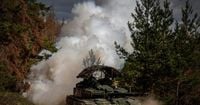In a dramatic turn of events, Russian President Vladimir Putin announced a "ceasefire" just ahead of the 80th anniversary of the Soviet Union's victory over Nazi Germany in World War II. However, the reality on the ground paints a starkly different picture, as reports indicate continued assaults on Ukrainian territory.
On the morning of May 8, 2025, Ukrainian Air Force officials reported no missile strikes or drone activity in their airspace until 8:00 AM local time. Yet, this brief respite did not translate to a halt in hostilities. Russian aircraft bombarded the Sumy region in northern Ukraine, dropping guided bombs overnight. According to the prosecutor's office in Sumy, this assault resulted in the death of a 55-year-old woman and injuries to her 24-year-old son. Additionally, a 70-year-old woman was rescued from the rubble after being injured in the attacks.
"One residential building was completely destroyed, and three civilian houses along with seven farm buildings were damaged due to the shelling," reported the State Emergency Service of Ukraine. Despite the so-called ceasefire, Ukrainian military spokespersons have noted that fighting remains active, particularly on the eastern front. Military analyst Pawło Narożny stated, "From what my soldiers tell me, there is no ceasefire. Perhaps the fighting is less active, but it doesn’t smell like a ceasefire at all." This sentiment echoes the concerns raised by Andrij Kowałenko, head of the Kyiv government's Center for Counteracting Disinformation, who asserted that Russia is violating its own declared ceasefire by continuing to shell the Sumy region.
Putin's declaration of a ceasefire came at the end of April, stating it would be in effect from midnight on May 7-8 to midnight on May 10-11, ostensibly for humanitarian reasons. These dates coincide with the significant date of May 9, when Russia commemorates the victory over Nazi Germany. In stark contrast, Ukrainian President Volodymyr Zelensky dismissed the Kremlin's proposal for a mere three-day ceasefire, advocating instead for a more extended truce lasting 30 days, in line with strategies suggested by U.S. authorities.
As the situation unfolded, reports emerged that in the past 24 hours alone, Russian forces had launched one missile and conducted 18 airstrikes against Ukrainian positions, including attacks in the Dnipropetrovsk region. Here, Russian drones and artillery targeted the Nikopol district, resulting in injuries to an 83-year-old man who will receive outpatient treatment. This attack also caused significant property damage, igniting fires in a garage and an outbuilding, although Ukrainian emergency services managed to extinguish the flames.
Notably, the Kremlin's announcement of a ceasefire did not deter the ongoing violence. On the contrary, it has led to skepticism among military analysts and officials. "The Russian attacks have continued despite the three-day ceasefire," reported Ukrainian media, underscoring the dissonance between the Kremlin's claims and the realities faced by civilians and military personnel on the ground.
The situation in Ukraine remains precarious as both sides prepare for potential escalations. The Ukrainian military continues to bolster defenses while navigating a complex landscape of international diplomacy and humanitarian concerns. As the world watches, the implications of this conflict extend beyond the borders of Ukraine, influencing global security dynamics.
In summary, while the Kremlin's announcement of a ceasefire may have been intended to honor a historical milestone, the ongoing violence and casualties reveal a grim reality. The Ukrainian government remains resolute in its call for a more substantial ceasefire, seeking to protect its citizens and restore peace amidst a backdrop of continued aggression.




